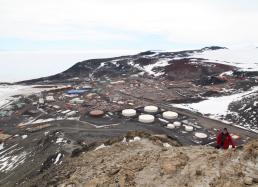3: Off to the Antarctic Ice
We were scheduled to meet at the Clothing Distribution Center (CDC) at 6:30 on the morning of December 7th (December 6th, to you folks following from Chicago, which is 19 hours behind Christchurch) to prepare for our flight for Antarctica. Due to jet lag, the 5 A.M. wake up call was not painful at all.
Because the weather is so unpredictable in McMurdo, we're required to wear our cold weather gear for the flight down, so at the CDC, we all stripped out of our street clothes and changed into wind pants, parkas, and bunny boots. After breakfast, orientation, and clearing customs, we boarded buses that took us to the tarmac, where our ride south—a C17 Globemaster—was waiting.
We entered the cavernous fuselage of this monstrous aircraft, the back half of which was filled with supplies, equipment, and our luggage on pallets. Seating consisted of airline-style seats down the middle and jump seats along the sides (see Photo #1 below.) Although the latter were less padded, with the lifejacket serving as a lumbar support, our big red parkas provided nice cushioning and the ride was surprisingly comfortable.
In addition to Raytheon personnel, National Science Foundation grantees, and Air Force personnel, large contingents of Italian and French research staff were on the flight. McMurdo is the largest base on Antarctica and serves as the gateway to the interior of the continent for scientists from many nations.
We landed on the sea ice right below McMurdo—it's unbelievable that a plane used to transport armored vehicles across the globe can land and take off from an ice runway (see Photo #2 below.) Upon exiting, we were greeted with bright sunshine from a cloudless sky and temperatures above freezing and were soon sweating in our Extreme Cold Weather Gear. To learn more about my flight and the sights that greeted me upon landing, take a look at my video "Heading to McMurdo Station" video.
The surroundings here are stunning. McMurdo base is located on Ross Island, dominated by the 12,500-foot-high active volcano, Mt. Erebus. Off to the west, across the Ross Ice Shelf, is the Royal Society Range, a chain of snow-covered volcanic peaks. The bedrock here is volcanic and black, contrasting sharply with the surrounding snow and ice.
A half-mile off lies Robert F. Scott's supply hut from his first Antarctic expedition, a square wooden structure with a pyramidal roof (see Photo #3 below.) With its very utilitarian feel, the base itself is not as picturesque, consisting of prefabricated buildings of various colors and designs (see Photo #4 below). Up the hill from the base are the large fuel depots and windmills that help power the station.
The base is at peak capacity right now and bustling with activity. All manner of tracked and wheeled vehicles operate around the camp, and several types of fixed-wing aircraft as well as helicopters come and go. Construction of the remote camp on the Beardmore Glacier, our final destination, just got finished, and the first science teams set out today. We have about a week of preparations ahead of us before we'll join them. Nate and Josh will return from their overnight cold weather survival training today (Nate will give you more details about survival training in the next dispatch.) The rest of us will take the course on Friday and Saturday, and I have to confess to a boyish excitement about building my own snow shelter and sleeping in it.
We'll also receive training in how to recognize the signs of altitude sickness, which is one of the most severe risks we'll face during our fieldwork. Other courses include learning how to ride snowmobiles, mandatory lab safety and environmental courses, and instructions on how to properly use radio and satellite communications from our camp. We also have to inspect all our shipped equipment and re-pack it for the flight to the Beardmore Camp, so busy week lies ahead.
Life on the base is basic but comfortable. We reside in dorm rooms and meals are served in a large mess hall, with fixed hours. The science support here is fantastic—we're networked and have a small office to work from, and a capable staff helps us with all aspects of our planning and work. Last night, between jet lag, 24-hour daylight, and a slat in my bunk breaking under me in the middle of the night and threatening to spear the guy below me, my sleep was restless and unsatisfying. Hopefully it won't take long to adjust....
More soon,
Pete




